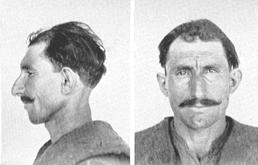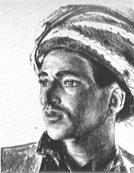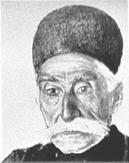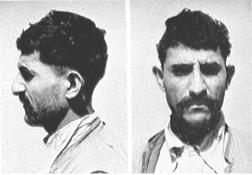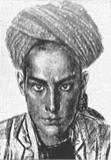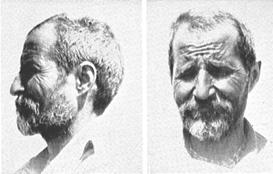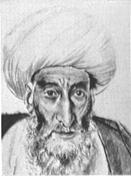|
(Photographic Supplement, Plate 18)
The individuals shown in the preceding plate might be generally classified within the Irano-Afghan branch of the Mediterranean race, the main diagnostic features of which are an extreme vault length, face height, and nose height. In many instances extreme nasal convexity and prominence, and in others an extremely high cranial vault are additional features. FIG. 1 (2 views, photo Henry Field. Courtesy of the Field Museum of Natural History, Chicago). A Lur from Luristan, Iran. This Persian tribesman shows in exaggerated degree the great nasal prominence often associated with this branch of the Mediterranean race, and endemic among many Near Eastern peoples. Not only is the nose convex and salient, but also the forehead is sloping, and the chin receding, although the mandible is deep.
FIG. 2 (1 view, tempera painting by Iacovleff). The same racial characters, typical among Kurds, appear in this Baghdadi Kurd in less exaggerated form.
FIG. 3 (1 view, tempera painting by Iacovleff). Although one cannot be sure of the head form of this venerable Persian official from Teheran, his facial features are characteristically Irano-Afghan.
FIG. 4 (2 views, photo Gordon T. Bowles). A Mohmand tribesman from eastern Afghanistan. The Afridis and Mohmands of the Khyber Pass country, the traditional harriers of the Northwest Frontier Province, are of the same racial type, for the most part, as the Persians and the Afghanis. This individual might be a brother of the Luri (Fig. 1) from the opposite end of the Irano-Afghan plateau.
FIG. 5 (1 view, tempera painting by Iacovleff). An Afghan, the "son of a nomadic chief." This youth possesses the high, narrow cranial vault common to one variety of the Irano-Afghan race.
FIG. 6 (2 views, photo Wm. M. Shanklin). A tribesman from the desert border of northeastern Syria, this gray-bearded man possesses the high cranial vault mentioned above.
FIG. 7, (2 views, photo Gordon T. Bowles) Closely similar to the Syrian desert border tribesman is this Afridi from eastern Afghanistan. Its high, narrow cranial vault, in combination with a great facial and nasal height, and its general cast of cranial features makes this type nearly identical with that of the Corded people who invaded Europe from the east toward the beginning of the third millennium B.C.
FIG. 8 (1 view, tempera painting by Iacovleff). This Persian from Teheran seems to belong to the same general branch of the Irano-Afghan race as the two preceding. The great length of his nose is an attribute of senility as well as a racial character.
|
